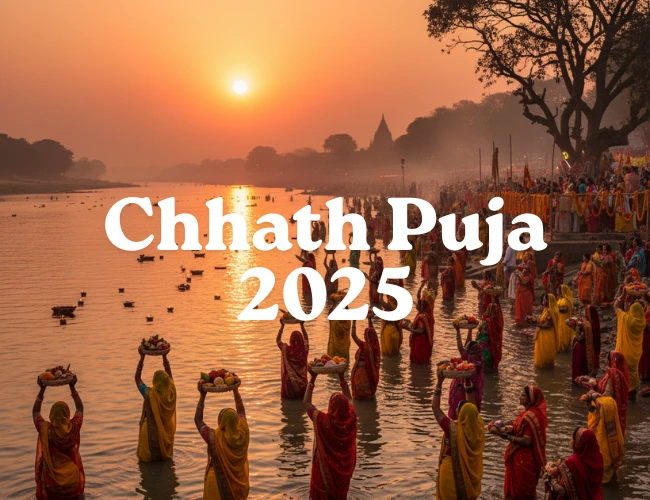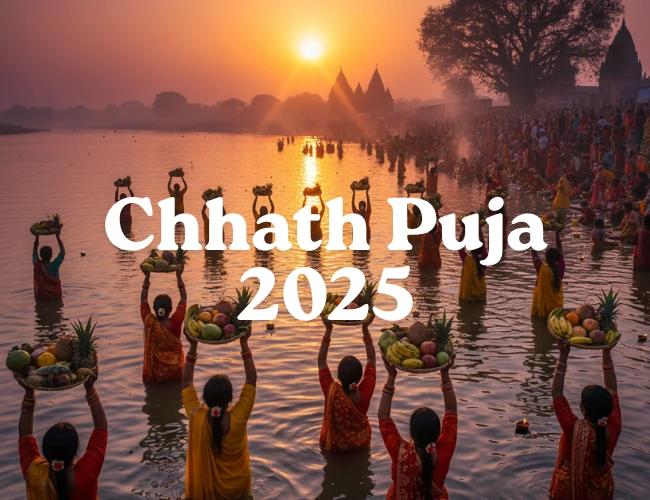Every year, as the golden rays of the sun reflect upon the calm waters of rivers and ponds in Bihar, Jharkhand and Eastern Uttar Pradesh, a divine aura takes over the air — it’s time for Chhath Puja. This festival, one of the most revered and eco-friendly Hindu celebrations, is not just a ritual – it’s an emotion deeply woven into the cultural and spiritual fabric of India. Women dressed in traditional sarees, singing folk songs, offering Arghya (water offering) to the setting and rising sun, and fasting with utmost devotion — all make Chhath Puja a sight of sheer faith and purity.
What makes Chhath Puja stand out is its deep spiritual significance, unique rituals and the unwavering discipline of devotees. It’s not about lavish celebrations or material offerings but about faith, cleanliness and gratitude to the forces of nature — especially the Surya Devta (Sun God) and Chhathi Maiya.
Let’s explore in detail the story, rituals, traditions and significance of Chhath Puja — a festival that beautifully symbolizes devotion, nature and the eternal bond between humans and divine energy.

What is Chhath Puja?
Chhath Puja is a Vedic Hindu festival dedicated to the worship of Surya Dev (the Sun God) and Chhathi Maiya (the goddess who is considered the sister of the Sun God). It is observed mainly in Bihar, Jharkhand, Eastern Uttar Pradesh and some parts of Nepal. However, over the years, it has found its presence across India and even abroad, wherever the Bihari diaspora has settled.
The word “Chhath” means six, as the festival is celebrated on the sixth day (Shashthi) of the Kartik month in the Hindu lunar calendar — usually falling six days after Diwali. It is believed that worshipping the Sun during this time brings prosperity, health and happiness to the family.
Why is Chhath Puja Celebrated?
The origins of Chhath Puja date back to ancient times. It is believed that the ritual began during the Mahabharata and Ramayana eras:
- In the Ramayana: When Lord Rama and Goddess Sita returned to Ayodhya after 14 years of exile, Sita performed the Chhath Puja by offering prayers to the Sun God to express gratitude and seek blessings for prosperity.
- In the Mahabharata: Draupadi and the Pandavas also performed Chhath Puja to regain their lost kingdom and to find peace and strength during difficult times.
The worship of the Sun God is symbolic of recognizing the vital role of nature in sustaining life. It is believed that the Sun’s rays have healing powers and offering prayers during sunrise and sunset purifies both body and soul.
Significance of Chhath Puja
Chhath Puja holds immense spiritual, environmental and cultural importance. Unlike other festivals, there is no idol worship — the Sun itself is considered the deity. This symbolizes purity and the universal nature of energy that sustains life.
1. Spiritual Significance
The festival is about gratitude and self-purification. Devotees observe strict discipline, fasts and rituals to cleanse their mind and body. The process is believed to help one attain peace, prosperity, and longevity.
2. Environmental Significance
Chhath Puja is one of the most eco-friendly festivals in India. The rituals are performed in natural water bodies and offerings are made from organic ingredients like fruits, sugarcane, rice and jaggery. It promotes harmony with nature and respect for natural elements.
3. Social and Cultural Significance
It unites families and communities. During the four days of the festival, people from all walks of life come together to prepare, sing folk songs and celebrate. It’s an expression of collective devotion and community bonding.
Where is Chhath Puja Celebrated?
While Bihar is the heartland of Chhath Puja, it is also celebrated with immense enthusiasm in:
- Jharkhand and Eastern Uttar Pradesh: Particularly in cities like Varanasi, Gorakhpur and Deoria.
- Delhi and Mumbai: Due to a large Bihari population, rivers like Yamuna and lakes in Mumbai become major gathering spots.
- Nepal: Especially in the Mithila region, where traditions mirror those of Bihar.
- Abroad: In countries like Mauritius, Fiji and the United States, the Bihari diaspora continues to celebrate the festival, keeping their cultural roots alive.
Why Chhath Puja is So Important for Bihari People
For Biharis, Chhath Puja is not merely a ritual — it’s an identity. It reflects the soul of Bihar — simplicity, devotion and endurance. Even those who live miles away from their homeland ensure to return for this festival. The emotional connection runs so deep that many people plan their entire year around this celebration.
The traditional songs, the mesmerizing sight of Arghya at sunrise and the sense of unity it brings — all make Chhath an inseparable part of Bihari culture. It’s said, “Bihar me Chhath nahi manaya to kya kiya?” (If you haven’t celebrated Chhath in Bihar, you’ve missed its true essence.)
The Four Days of Chhath Puja: Step-by-Step Rituals
Chhath Puja is a four-day festival marked by fasting, bathing, offering prayers and maintaining purity in both actions and thoughts.
1. Nahay-Khay (Day 1)
The first day marks the beginning of the ritual. Devotees take a dip in a holy river or pond, symbolizing purification of the body. They bring the holy water home to prepare the day’s food. The meal is strictly vegetarian and cooked without onions or garlic — usually lauki-bhaat (bottle gourd and rice) is eaten. This marks the start of the fasting period.
Significance:
It purifies the devotee’s body and surroundings, preparing them mentally and spiritually for the days ahead.
2. Kharna (Day 2)
On this day, devotees observe a strict fast throughout the day — no water, no food. In the evening, after sunset, they break the fast with gur ki kheer (jaggery rice pudding), fruits and chapati, all prepared without salt or garlic. After this meal, the 36-hour long nirjala vrat (fast without water) begins.
Significance:
It symbolizes self-control, discipline and surrender to divine energy.
3. Sandhya Arghya (Day 3)
This is the most important day of Chhath. Devotees, dressed in new traditional clothes, gather at the ghats (riverbanks) with beautifully decorated soops (bamboo baskets) containing thekua, fruits, sugarcane and coconut. They offer the first Arghya to the setting sun while standing in waist-deep water, accompanied by devotional folk songs and prayers.
Significance:
The setting sun represents the end of darkness and difficulties in life. Offering Arghya at sunset is symbolic of thanking the Sun for the energy that sustains life.
4. Usha Arghya (Day 4)
Before sunrise, devotees return to the riverbank to offer the final Arghya to the rising sun. The morning atmosphere is filled with chants, songs and a divine calmness. After the rituals, devotees break their fast, often with ginger water and fruits.
Significance:
The rising sun represents new beginnings, hope and life. The ritual symbolizes spiritual awakening and renewal.
Offerings (Prasad) of Chhath Puja
Every element used in Chhath Puja has its own meaning and purpose. The main offerings include:
- Thekua: A traditional sweet made with wheat flour and jaggery, symbolizing purity and devotion.
- Sugarcane: Represents sweetness and prosperity.
- Coconut, bananas and fruits: Offered as gratitude for nature’s gifts.
- Earthen lamps (diya): Signify light, purity and positivity.
All offerings are placed in soops (bamboo baskets) and handled with care and respect throughout the rituals.
Folk Songs and Cultural Essence
Music and devotion go hand-in-hand during Chhath Puja. Traditional songs like “Kaanch hi baans ke bahangiya”, “Uga hai suruj dev”, and “Chhathi Maiya ke gana” echo through the air, creating a spiritual connection between generations. These songs narrate stories of faith, family and gratitude, passed down from mothers to daughters.
Dress Code and Customs
Women wear traditional sarees, often in bright yellow or red colors, representing energy and purity. Men wear dhoti-kurta. Devotees maintain utmost cleanliness, abstain from alcohol and non-vegetarian food, and keep their surroundings spotless — a key principle of this festival.
Scientific Angle Behind Chhath Puja
Interestingly, the rituals also have a scientific base. Standing in water during sunrise and sunset allows the body to absorb solar energy efficiently, enhancing blood circulation and detoxification. Fasting helps cleanse the digestive system, while deep breathing during prayers improves mental clarity and calmness.
Chhath Puja 2025 Dates
In 2025, Chhath Puja will be celebrated from October 26 to October 29.
- Nahay Khay: October 26
- Kharna: October 27
- Sandhya Arghya: October 28
- Usha Arghya: October 29
Conclusion
Chhath Puja is not just a festival – it’s a journey of discipline, purity, and devotion. It teaches us the values of gratitude, patience, and respect for nature — lessons that remain timeless. In a world that’s moving fast and often disconnected from nature, Chhath reminds us to pause, to thank the Sun that gives us life and to celebrate simplicity with devotion.
Whether you witness the glowing diyas on the ghats of Patna, the melodious songs by the riverbanks of Ganga, or the quiet devotion of families in metropolitan cities — the spirit of Chhath Puja remains the same: pure, sacred and deeply human.
For more Spiritual and Festivals Updates, Please Follow Popnewsblend.com

Hi, I’m Prashant Jain — a curious soul, storyteller, and content creator at heart.I’ve always been drawn to the world of entertainment, travel, sports, health & lifestyle — not just as a writer, but as someone who genuinely lives these experiences. Whether I’m binge-watching the latest OTT series, exploring offbeat spiritual destinations in India, or diving deep into wellness routines and cricket match insights, I love sharing what I discover with like-minded readers.
PopNewsBlend is my way of blending personal journeys with meaningful stories — ones that inform, inspire, and keep you ahead of the curve. Everything I write comes from real observations, hands-on experiences, and a deep passion for understanding the world around us.
Discover more from Popnewsblend
Subscribe to get the latest posts sent to your email.







